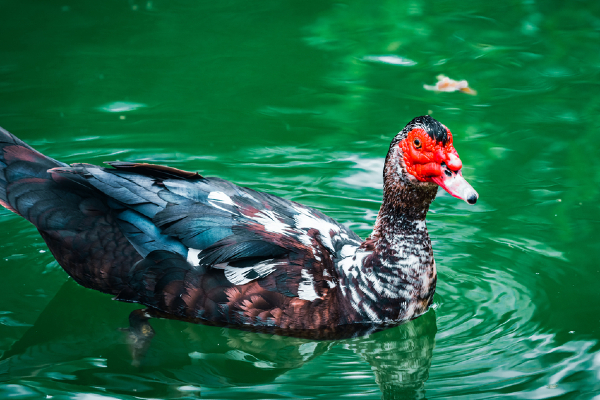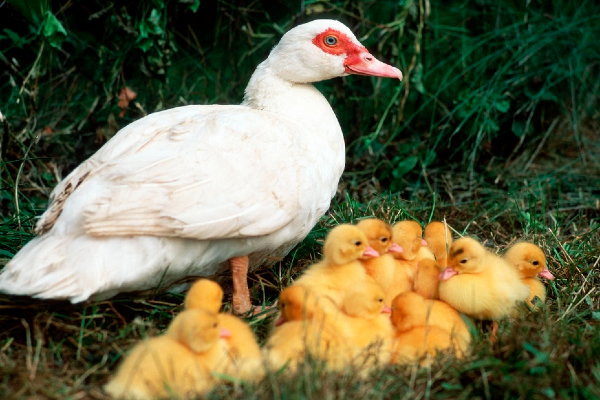The Muscovy Duck is a domesticated duck that is found all over the world. They are usually white with black markings, but can also be black or any other color. Muscovy Ducks are heavier than most ducks and have a wider bill. They are excellent flyers and strong swimmers. Muscovy Ducks are raised for their meat, eggs, and feathers. They can also be kept as pets.

Muscovy Duck Description
Muscovy Ducks are large birds that are native to Mexico and parts of Central and South America. They are easily distinguished from other ducks by their red facial skin and bare red caruncles on their face. Muscovies also have drab-colored plumage and long claws on their feet, which they use for perching in trees. These ducks typically weigh between 3 and 6 pounds, with males being larger than females. Muscovies are excellent swimmers and can often be seen paddling around in ponds and lakes. They primarily eat insects, fruits, and vegetables, but will also eat small fish and amphibians. Muscovies usually nest in tree cavities or in nest boxes that are provided by humans. These ducks typically lay 8-12 eggs per clutch, and both parents help to care for the ducklings. Muscovies typically live for 10-15 years in the wild, but can live up to 20 years in captivity.
Muscovy Duck Habitat
The Muscovy Duck is a large tropical duck that is native to parts of South and Central America. The Muscovy Duck is the only member of the Cairina genus, which contains ducks that are adapted to live in wetlands. The Muscovy Duck is a popular bird for zoos and aviaries due to its attractive plumage and docile nature. In the wild, the Muscovy Duck inhabits swampy areas, rivers, lakes, and marshes. The Muscovy Duck is an important species for wetland ecosystems as it helps to control insect populations and disperse seeds. The Muscovy Duck is listed as Least Concern by the IUCN due to its large range and stable population. However, the Muscovy Duck faces threats from habitat loss and hunting.
Muscovy Duck Diet
Muscovy Ducks are omnivorous and their diet consists of a variety of plant and animal matter. They will eat leaves, twigs, berries, fruits, and seeds as well as insects, snails, frogs, and small fish. Muscovy Ducks often forage in farmers’ fields and can cause damage to crops. In some areas, they are considered to be pests and their populations are controlled through hunting and trapping. In captivity, Muscovy Ducks can be fed a commercial duck food or a diet of chopped greens, grains, and a small amount of meat or poultry. It is important to provide them with access to clean water at all times so that they can drink and bathe. Muscovy Ducks are interesting birds and can make good pets if their dietary needs are met.
Muscovy Duck Size
Muscovy Ducks measure between 74 and 90 cm (29 and 35 in) in length. They have long necks and tails, and their wingspan is between 115 and 150 cm (45 and 59 in). Muscovy Ducks weigh between 2.7 and 4.5 kg (6 and 10 lb), making them one of the heaviest duck species. The Muscovy Duck is sexually dimorphic, with males being significantly larger than females. In addition to their size, Muscovy Ducks also differ from other duck species in their appearance. They have black plumage with white patches on their wings, and their bills are red with a black band around the base. Muscovy Ducks are native to Mexico, Central America, and South America, but they have been introduced to North America, Europe, Asia, and Africa.

Muscovy Duck Lifespan
Muscovy Ducks have a lifespan of 10 to 12 years in the wild. In captivity, they can live up to 20 years if well cared for. Muscovy Ducks are native to South and Central America, but they have been introduced to North America, Europe, Asia, and Australia. Muscovy Ducks are the largest species of Duck in the world, and they are the only member of the Cairina genus. Muscovy Ducks are omnivorous, and their diet consists of plants, insects, small mammals, and fish. Muscovy Ducks are sexually dimorphic, with males being larger than females. Muscovy Ducks mate for life, and they typically lay 7 to 15 eggs per clutch. Muscovy Ducks are generally peaceful birds, but they can be aggressive towards other ducks if they feel threatened. Muscovy Ducks are popular as pets and as traditional dishes in some cultures. The Muscovy Duck is classified as Least Concern by the IUCN Red List.
Muscovy Duck Behavior
Muscovy Ducks are interesting creatures with a variety of behaviors that set them apart from other ducks. One such behavior is their nesting habits. Muscovy Ducks typically nest in areas with dense vegetation, which provides them with cover from predators. The female Muscovy Duck will line her nest with down feathers and other soft materials, and she will incubate her eggs for about 35 days. Once the ducklings hatch, the female will care for them for several weeks until they are old enough to fend for themselves. Muscovy Ducks are also known for their impressive flying abilities. They are strong fliers and can cover long distances with ease. In addition, Muscovy Ducks are excellent swimmers and divers. They are able to dive deep into the water in search of food, and they are also able to swim quickly to escape predators. As a result of their unique behaviors, Muscovy Ducks are an interesting and enjoyable animal to observe.
Muscovy Duck Speed
Muscovy Ducks are notoriously fast flyers, reaching speeds of up to 60 miles per hour. This makes them one of the fastest flying duck species in the world. Muscovy Ducks use their speed to escape predators and to migrate long distances. They are known to fly non-stop for hours at a time, covering hundreds of miles in a single day. The Muscovy Duck’s speed is an adaptation that has helped it to survive and thrive in the wild for centuries.
Muscovy Duck Hunting
Muscovy Ducks are a popular game bird, prized for their dark meat and Muscovy Duck hunting is a popular pastime in many parts of the world. Muscovy Ducks are large birds, with males typically weighing between 4 and 6 kg (8.8 and 13.2 lb), and females usually weigh 2–4 kg (4.4–8.8 lb). They have long necks and bodies, and relatively short legs. The Muscovy Duck’s wings are also relatively short, making them less proficient at flying than other ducks, but this also makes them easier to catch. Muscovy Ducks are generally shy birds, but they can be lured into traps with decoys or baited with corn or other grain. Once caught, Muscovies can be easily dispatched with a sharp blow to the head. Muscovy Duck hunting is a popular sport in many parts of North America, Europe, and Asia, and the birds can be found in a variety of habitats, including marshes, ponds, and riverbanks. Muscovies are also hunted for their feathers, which are used to make quill pens, and their down is used to fill pillows and comforters. Muscovy Duck hunting is regulated
Conclusion
Muscovy ducks are a great option for those looking for an interesting and unique pet. They are calm, friendly, and make great watchdogs. If you’re interested in adding a Muscovy duck to your family, be sure to do your research first to find an reputable breeder. Thanks for reading!
Frequently Asked Question

